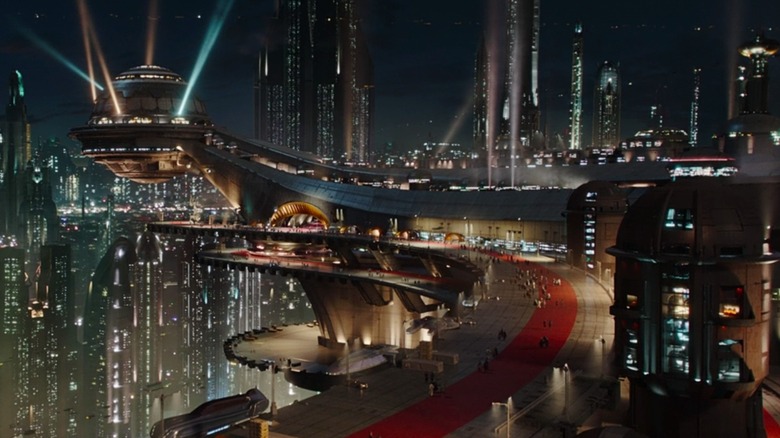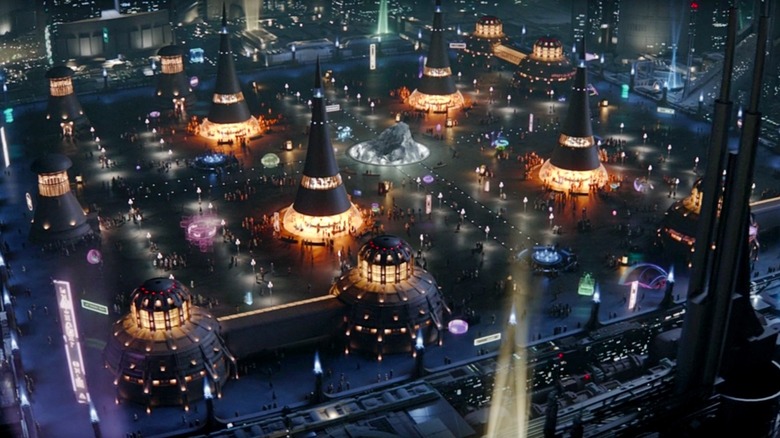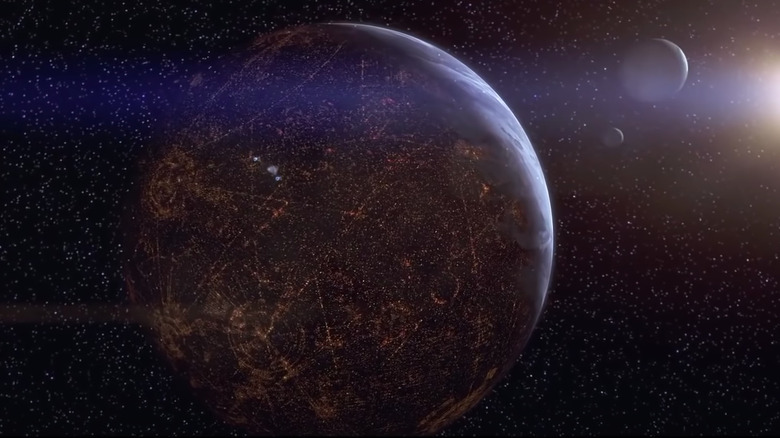How Star Wars' Coruscant Became The Planet-Wide City Of Your Nightmares
This post contains spoilers for the latest episode of "The Mandalorian."
The planet-swallowing city of Coruscant was re-introduced in spectacular form in Chapter 19, "The Convert" of "The Mandalorian." On a star map, Coruscant is considered to be the center of the galaxy for trade and travel route purposes, although it is not technically the actual center of the "Star Wars" universe. In "The Convert," Dr. Pershing (Omid Abtahi) returns to the series after we last saw him pursuing Grogu for potential clone research at the behest of Moff Gideon (Giancarlo Esposito). It's Pershing's first time on Coruscant, and during a debriefing about the planet, the word ecumenopolis is heard — the term for an all-encompassing city-planet. This is a clear reference and homage to Isaac Asimov's "Foundation" universe and further evidence that "The Mandalorian" isn't afraid to wear its sci-influences proudly on its sleeve.
Home to the wealthiest elites and the most powerful politicians, Coruscant also contains some of the most ruthless criminals and crime syndicates that reside below the clouds. There are over 5,000 levels of Coruscant that have been built up over centuries. There's an ominous, nightmarish quality to the city even in the more opulent districts where Dr. Pershing is being courted, such as the opera house that we last saw in "Star Wars: Episode III – Revenge of the Sith" where Chancellor Palpatine tells Anakin Skywalker about Darth Plagueis and the ability to cheat death. There's a direct correlation between that speech and Dr. Pershing's area of expertise that helped to create new organisms called "strandcasts" that led to the creation of Supreme Leader Snoke. Spooky stuff.
About 5,000 years before the rise of Palpatine, the Jedi Temple was built on top of a Sith shrine, revealing that the entire history of Coruscant was built on top of evil itself.
The many levels of Coruscant
Offering up a quick history lesson, Coruscant was thought to be the original homeworld of humans — a race considered to be the best at exploring and colonizing the untamed planets around the galaxy. Over the centuries, many different dictatorships and democracies thrived and were overthrown, eventually leading up to the Galactic Republic as the ruling authority at the start of the prequel trilogy. Coruscant grew considerably under that rule and newly chartered hyperspace routes became new avenues for trade. The routes also opened up opportunities for a vast wave of alien species to live and work on the planet. The new influx of races gradually led to unprecedented growth with the construction of countless residential levels and sectors that went well beyond the city's skyline.
In the third episode of season 3, it's mentioned that over a trillion people work and live on Coruscant. Dr. Pershing and his colleague Elia Kane have been re-integrated into the New Republic after serving the last remnants of the Empire. The areas they visit mostly reside in the Federal District. The galaxy's rulers are located here as well as the Jedi Temple which would later become the Imperial Palace.
Kane also takes Pershing to a decommissioned Imperial Star Destroyer in the scrapyards of Coruscant, an area we haven't seen before in "The Mandalorian." The next level down from the Federal District is the Collective Commerce District, commonly referred to as Coco Town where Dex's Diner is located from "Star Wars: Episode II – Attack of the Clones."
The Uscru district is where Dr. Pershing gives his opening speech at the galaxies opera house, again echoing Palpatine's speech to Anakin. Pershing winds up being punished severely in "The Convert" for wanting to continue that research. Maybe the New Republic is doomed to repeat the horrors of the planet's history.
Coruscant represents the destruction of the natural world
The darker side (pun intended) of Coruscant begins to bubble up below the Uscru District one level down in the Entertainment District where the Outlander Club was located from "Attack of the Clones." A new area called The Works is also seen when Count Dooku visits Darth Sidious under the cover of night.
The lower, seediest levels of the planet have mainly been seen in the "Knights of the Old Republic" video game and in "Star Wars: The Clone Wars" when Ahsoka goes into hiding after being framed for bombing the Jedi Temple. Maybe Ahsoka Tano will revisit the bowels of Coruscant in her live-action series premiering later this year.
Besides all of the treachery and suffering going on in the bowels of the planet, Coruscant also represents how the Galactic Empire was a true eater of worlds, gobbling up resources to benefit the Core planets and aid in the constriction of the Death Star — the ultimate planet-killing weapon. One of the most lush, beautiful natural locations in "Star Wars" was Princess Leia's home planet of Alderaan. When the Death Star destroyed the planet in "Star Wars: Episode IV – A New Hope," there were riots in the Alderaanian District located around level 3,000 of Coruscant.
In "The Convert," Pershing and Kane visit Monument Plaza, where Pershing sees the peak of Coruscant's highest mountain, Umate, which was a part of the Manarai range before the tall city built up over them. Umate has appeared in the novel "The High Republic: Light of the Jedi," episodes of "The Clone Wars" and in the Special Edition of "Return of the Jedi." The Umate mountain peak is the ultimate symbol of Coruscant's complete disregard for the natural order of things. Coruscant even has its own climate control system! The true nightmarish quality of Coruscant isn't the seedy underbelly below. That they've built a mountain monument to show the city's dominance over nature and the galaxy is a much more ostentatious kind of horror, hidden in plain sight.
"The Mandalorian" is streaming only on Disney+. New episodes premiere on Wednesdays.


